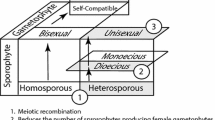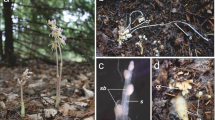Abstract
According to environmental-based theories on the maintenance of sexual reproduction, sexual and asexual populations may coexist if they occupy different ecological niches. The aphid Rhopalosiphum padi offers a good opportunity to test this hypothesis since sexual and asexual lineages show local coexistence during a large part of their respective life-cycles. Because these two reproductive variants are morphologically identical but genetically distinct, we first characterized them using genetic markers in populations of R. padi in areas where sexual and asexual lineages may occur in sympatry. We then inferred the natal host plant of sexual and asexual genotypes by analysing stable isotopic ratios and showed that sexual ones mostly originated from C3 Poaceae while asexual ones originated from C3 and C4 plants, although the majority came from C4 Poaceae. These findings indicate that ecological niches of sexual and asexual lineages of R. padi differ, offering a plausible explanation for the local coexistence of the two reproductive modes in this species through habitat specialisation.


Similar content being viewed by others
References
Bell G (1982) The masterpiece of nature, the evolution and genetics of sexuality. University of California Press, Berkeley
Bianchi FJJA, Booij CJH, Tscharntke T (2006) Sustainable pest regulation in agricultural landscapes: a review on landscape composition, biodiversity and natural pest control. Proc R Soc B Biol Sci 273:1715–1727
Boecklen WJ, Yarnes CT, Cook BA, James AC (2011) On the use of stable isotopes in trophic ecology. Annu Rev Ecol Evol Syst 42:411–440
Case TJ, Taper ML (1986) On the coexistence and coevolution of asexual and sexual competitors. Evolution 40:366–387
Delmotte F (2001) Evolution des modes de reproduction chez le puceron Rhopalosiphum padi (L.): apports de la génétique des populations et de la phylogénie moléculaire. Thèse de doctorat. pp. Ecole Nationale Supérieure d’Agronomie de Rennes, Rennes
Delmotte F, Leterme N, Gauthier JP, Rispe C, Simon JC (2002) Genetic architecture of sexual and asexual populations of the aphid Rhopalosiphum padi based on allozyme and microsatellite markers. Mol Ecol 11:711–723
Doncaster CP, Pound GE, Cox SJ (2000) The ecological cost of sex. Nature 404:281–285
Fox J, Weisberg S (2011) An R companion to applied regression, second edition. Thousand Oaks, Sage. http://www.r-project.org/package/car
Gilabert A, Simon JC, Mieuzet L, Halkett F, Stoeckel S, Plantegenest M, Dedryver CA (2009) Climate and agricultural context shape reproductive mode variation in an aphid crop pest. Mol Ecol 18:3050–3061
Glesener RR, Tilman D (1978) Sexuality and components of environmental uncertainty: clues from geographic parthenogenesis in terrestrial animals. Am Nat 112:659–673
Haag CR, Ebert D (2004) A new hypothesis to explain geographic parthenogenesis. Ann Zool Fenn 41:539–544
Halkett F, Plantegenest M, Prunier-Leterme N, Mieuzet L, Delmotte F, Simon JC (2005) Admixed sexual and facultatively asexual aphid lineages at mating sites. Mol Ecol 14:325–336
Halkett F, Plantegenest M, Bonhomme J, Simon JC (2008) Gene flow between sexual and facultatively asexual lineages of an aphid species and the maintenance of reproductive mode variation. Mol Ecol 17:2998–3007
Hartfield M, Keightley PD (2012) Current hypotheses for the evolution of sex and recombination. Integr Zool 7:192–209
Hoffmann AA, Reynolds KT, Nash MA, Weeks AR (2008) A high incidence of parthenogenesis in agricultural pests. Proc R Soc B Biol Sci 275:2473–2481
Kondrashov AS (1988) Deleterious mutations and the evolution of sexual reproduction. Nature 336:435–440
Layman CA, Araujo MS, Boucek R, Hammerschlag-Peyer CM, Harrison E, Jud ZR, Matich P, Rosenblatt AE, Vaudo JJ, Yeager LA, Post DM, Bearhop S (2012) Applying stable isotopes to examine food-web structure: an overview of analytical tools. Biol Rev 87:545–562
Lehto MP, Haag CR (2010) Ecological differentiation between coexisting sexual and asexual strains of Daphnia pulex. J Anim Ecol 79:1241–1250
Lynch M (1984) Destabilizing hybridization, general-purpose genotypes and geographic parthenogenesis. Q Rev Biol 59:257–290
Mole S, Joern A, Oleary MH, Madhavan S (1994) Spatial and temporal variation in carbon isotope discrimination in prairie graminoids. Oecologia 97:316–321
Muller HJ (1964) The relation of recombination to mutational advance. Mutat Res 1:2–9
Plantegenest M, Le May C, Fabre F (2007) Landscape epidemiology of plant diseases. J R Soc Interface 4:963–972
Pritchard JK, Stephens M, Donnelly P (2000) Inference of population structure using multilocus genotype data. Genetics 155:945–959
R Development Core Team (2012) R: a language and environment for statistical computing. pp. R Foundation for Statistical Computing 2009, Vienna, Austria
Rispe C, Simon J-C, Pierre J-S (1996) Fitness comparison between clones differing in their ability to produce sexuals in the aphid Rhopalosiphum padi. Entomol Exp Appl 80:469–474
Simon J-C, Rispe C, Sunnucks P (2002) Ecology and evolution of sex in aphids. Trends Ecol Evol 17:34–39
Vandel A (1928) La parthénogénèse géographique. Contribution à l’étude biologique et cytologique de la parthénogénèse naturelle. Bulletin biologique de la France et de la Belgique 62:164–281
Vialatte A, Dedryver CA, Simon JC, Galman M, Plantegenest M (2005) Limited genetic exchanges between populations of an insect pest living on uncultivated and related cultivated host plants. Proc R Soc B Biol Sci 272:1075–1082
Vialatte A, Simon J-C, Dedryver C-A, Fabre F, Plantegenest M (2006) Tracing individual movements of aphids reveals preferential routes of population transfers in agroecosystems. Ecol Appl 16:839–844
West SA, Lively CM, Read AF (1999) A pluralist approach to sex and recombination. J Evol Biol 12:1003–1012
Acknowledgments
We thank J-F. Le Gallic, P. Lhomme and L. Mieuzet for their help with sampling and genotyping, and T. Forde and J. Foucaud for comments on the manuscript. Isotopic analyses were performed at the Mylnefield Research Services (Scotland, UK). This research was supported by Bayer CropScience France and a CIFRE grant from the Association Nationale de la Recherche Technique.
Author information
Authors and Affiliations
Corresponding authors
Rights and permissions
About this article
Cite this article
Gilabert, A., Simon, JC., Dedryver, CA. et al. Do ecological niches differ between sexual and asexual lineages of an aphid species?. Evol Ecol 28, 1095–1104 (2014). https://doi.org/10.1007/s10682-014-9730-y
Received:
Accepted:
Published:
Issue Date:
DOI: https://doi.org/10.1007/s10682-014-9730-y




